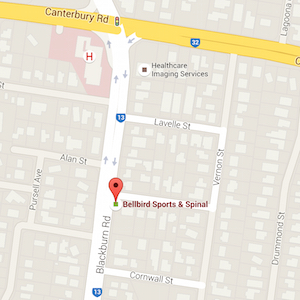SCHOOL BAGS, PAIN AND CHILDREN – IS THERE A LINK?
Choosing a school bag is a delicate art of negotiation. Some schools take the decision out of your hands altogether. This blog is going to discuss three key factors regarding school bags including choice and correct fit.
- What is known about the links between backpack use and pain (back, neck and shoulder pain are the most common symptoms)
- How to select the most appropriate backpack
- Current recommendations regarding the use of backpacks

Backpack and back pain – What are the connections?
Backpacks are the ‘go-to’ choice (90% of students use backpacks)1, and with good reason. They offer an excellent solution that allows students to transport their school materials to and from school while allowing a stable and symmetrical load that is close to the body2. Having said that, there are known issues with backpacks and how they are used that can result in painful experiences2. A study found that musculoskeletal symptoms are reported by 77.1% of students and that these could include the neck, shoulder, upper back, lower back and knee pain2,3. Many students carry loads exceeding the recommendations, and this can cause the previously mentioned structures to become painful. Some backpacks, when weighed for the research studies, were heavier than 7kg, this would mean the wearer would have to weigh over 70kg for this to be within the recommended weight limits (in grades 4-5)4.
Girls are reported to be at higher risk5, the exact reason behind this is unknown, but it is theorised to be related to their earlier rapid growth spurts that begin during the ages transitioning into high school, where you see the biggest increase in backpack weights5,6. Having said that, the following advice is important for a child of any gender. As all young students experience significant growth spurts, that often increase spine length without substantially adding mass3, and this can challenge the supporting muscular strengths and coordination.

Which backpack is the right one?
Just as the most effective exercise is the one done, the most useful backpack is the one worn. So please involve the intended wearer in the decision-making process and ask the questions “would you wear this? And, “would you wear this correctly?”
Additionally, the following tips will be helpful in selecting the correct bag:
- Backpacks have been shown to be less demanding on the body than shoulder bags1,7
- Make sure the bag itself is not too heavy (lighter materials include vinyl and wool)2
- All straps and handles should be sufficiently padded7. It should be comfortable when the straps are tightened to ensure no gaps4
- It should be able to be worn comfortably with straps over both shoulders2,4
- The shoulder straps should have a width of 5cm 2
- When worn, the upper border of the bag should not be higher than the shoulders2
- The breadth of the backpack, across the torso, should not limit arm movement4
- There should be both waist and chest straps to reduce forces on the shoulders4. Despite these helping reduce back pain, they are often not utilised4 – so encouragement to use these straps should be given
With the backpack selected, what’s the best way to use it?
Do not pack unnecessary things, reduce the volume of books by planning out what books are needed on what days2
When packing the bag make sure there are no book corners or anything else sharp that will push into the wearers back2
The typical recommendation for maximum weight is 10% of the wearer’s body weight5. However, how this load is introduced is important (see below) and a study looking specifically at safe backpack weights recommended 5% 3 – this variation of recommendation highlights that the human body is complex, and there are always several factors to consider.
Total school bag ‘use’ is a consideration of the bags weight and the duration and method of carriage4. We are starting to get a better understanding of how to increase our ‘loading’ (think ‘amount of physical work done’). And it’s a topic all on its own.
It has been shown that a wearer reporting fatigue or that the bag is too heavy is associated with higher levels of back and neck pain5. So, this can serve as a rule of thumb. However, if you would like a more structured way to safely introduce your child to wearing a backpack read on (otherwise skip to the Top Five Take Home Tips)!
How to introduce your child to using a backpack
When planning how much loading should take place, the next week should be no more than 20% more loading than the average of the last four weeks. This can be measured in many ways, and to my knowledge, this has not been scientifically tested (specifically with school bags), but here is a way to tackle this issue.
As the duration of the walk is generally not going to change, you can just consider the weight of the backpack – unless the walk is a lot longer then they are used to (in this case you might need to ease them into the walking as well). In the lead up to school, you can get them to walk the equivalent distance of a trip to school each day. In the first week, they would walk with just the backpack and a small amount of weight (doesn’t have to be school books for this training, it would be easier to measure the weight out with cans of food for example).
Each week add 20% more weight to the bag. Example;
| Week | Total Backpack weight (kg) | Wearer’s weight (kg) | Backpacks % of
wearer’s weight |
| One | 2 | 40 | 5% |
| Two | 2.4 | 40 | 6% |
| Three | 2.9 | 40 | 7.25% |
| Four | 3.5 | 40 | 8.75% |
| Five | 4 | 40 | 10% |
Loading it in the above manner should allow the wearer to safely wear 10% of their body weight. Then you just have to make sure the total weight of the backpack doesn’t exceed 10% when all the books, pens, laptop, charger, etc are added.
Top 5 Take Home Messages
- Having the wrong school backpack, or overloading the backpack can cause pain, but backpacks are still the recommended way to carry school supplies to/from school
- Planning ahead can help reduce the number of books etc. being carried to and from school
- Using the above advice will reduce the risk of pain associated with wearing a backpack
- Introducing the use of a backpack should be done gradually to allow the body to adapt
- More detail can be provided when you see your physiotherapist, this could include specific exercises to work on any troubled areas your child might have
Thank you for reading Chris’ post regarding School Bags. For more information please contact our friendly receptionists on (03) 9878 8088 or via email at bellbird@sports-spinal.com.au
Written by Christopher Snell
Thank you for reading our blog, please see our disclaimer here. For more information please contact our friendly receptionists on (03) 9878 8088.
References
1. Hong Y, Fong DTP, Li JX. The effect of school bag design and load on spinal posture during stair use by children. Ergonomics. 2011;54(12):1207-1213. doi:10.1080/00140139.2011.615415
2. Poursadeghiyan M, Azrah K, Biglari H, et al. The effects of the manner of carrying the bags on musculoskeletal symptoms in school students in the city of Ilam, Iran. Ann Trop Med Public Heal. 2017;10(3):600-605. doi:10.4103/ATMPH.ATMPH_109_17
3. Ismaila SO. Safe backpack weight limit for secondary school students in Ibadan, Southwestern Nigeria. Alexandria Eng J. 2018;57(2):547-554. doi:10.1016/j.aej.2017.01.007
4. Mohammadi S, Mokhtarinia H, Nejatbakhsh R, Scuffham A. Ergonomics evaluation of school bags in Tehran female primary school children. Work. 2017;56(1):175-181. doi:10.3233/WOR-162469
5. Grimmer K, Williams M. Gender-age environmental associates of adolescent low back pain. Appl Ergon. 2000;31(4):343-360. doi:10.1016/S0003-6870(00)00002-8
6. Haselgrove C, Straker L, Smith A, O’Sullivan P, Perry M, Sloan N. Perceived school bag load, duration of carriage, and method of transport to school are associated with spinal pain in adolescents: An observational study. Aust J Physiother. 2008;54(3):193-200. doi:10.1016/S0004-9514(08)70026-6
7. Yoon J-G. Correlations between Muscle Activities and Strap Length and Types of School Bag during Walking. J Phys Ther Sci. 2014;26(12):1937-1939. doi:10.1589/jpts.26.1937



